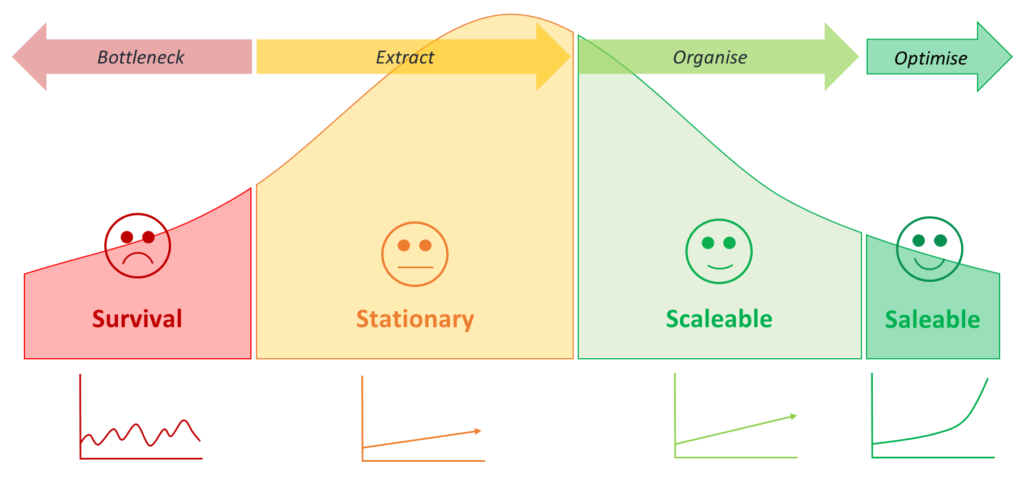In SYSTEMology® we differentiate between four stages of business development that any business goes through in one way or another. Here are the most typical characteristics of these stages:
Stage #1: Survival
- The business owner is in an endless loop of chasing the work, getting the work, and doing the work. This creates up and down performance with lumpy results.
- You’re still figuring out product/market fit, you spend 80 % of your time in problem-solving mode and you’re hustling your way through.
- You’re trying lots of new things but you never really take anything to completion.
- Your team (if you have one) makes things up as they go. It’s not clear who is doing what and when tasks are due. There are no systems or processes, and no one really likes them anyway.
Stage #2: Stationary
- In the stationary stage, the ups and downs have been smoothed out and you’re starting to see a little more consistency in the business. You have a loose way of doing things, but this is still typically trapped in the heads of your best team members.
- You may have a few documented systems but they’re more like unorganised notes scattered all over the place. This lack of system certainty makes your business team-member dependent.
- Your business often feels stationary. You’ve reached capacity and you can’t seem to break through to that next level of business.
- Even hiring new team members doesn’t break that deadlock, as your existing team members are too busy to teach them how to do things. This leads either to inconsistencies in execution of tasks, a high strain on the time resources of your team, rapid demotivation of new and existing staff, or all of it together.
Stage #3: Scalable
- Once you’ve got a good amount of your core business systems documented, this is where things start to get interesting. You have now proven your core business model works. You still need to extract and organise systems from all business departments, but you’re well on your way.
- System performance has improved dramatically, and you’re shifting the culture within your business. Your tools are clunky, and you still have to constantly remind your team to follow your process, but you’ve overcome any initial resistance.
- Now is the time to focus on increasing your business capacity by installing human resources systems, finance systems and management systems. You also need to develop the ability to solve business problems well before they develop into more serious problems.
Stage #4: Saleable
- You recognise your business as a collection of interdependent systems that can be engineered to deliver extraordinary outcomes. In this stage, you will have a clear ‘way’ of doing business, your operations run with the precision of a Swiss watch and your team upholds your systems-centred company culture.
- No longer are you dependent on specific team members for things to work. The systems work and the people work the system. This is a different level of business, where you’re able to rise above the noise and be deliberate and strategic in the work you do. You can begin to optimise your performance.
Comment below, which of the characteristics of your current stage resonate most with you.

